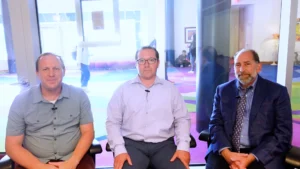Rob Klootwyk, Director, Interoperability at Epic, and Matthew Eisenberg, M.D., Associate Chief Medical Information Officer at Stanford Health Care, offer an in-depth discussion in this video of recent developments in standards and in Epic’s tools for information sharing.
They start their interoperability story with Epic’s creation of Care Everywhere in 2008. Klootwyk says that by 2014 they had connected 100% of their customer base. The platform included strict rules for security and other policies. The Carequality platform was the next iteration of data sharing with multiple EHR vendors and includes tools such as a provider directory.
Eisenberg says that Epic and Stanford put a lot of effort into explaining the benefits of record sharing with patients, and ensuring that privacy would be protected. Regional user groups accelerated adoption.
Automation now allows records from remote clinics and hospitals to be pulled up when a patient checks into a facility. Even more important, the records from different sources are combined so that all medications, etc. are in one place.
A good deal of the video is devoted to the potential of the Trusted Exchange Framework and Common Agreement (TEFCA), which was defined in the 20th Century Cures Act. Epic now rates each institution’s compliance with interoperability rules and policies.
Eisenberg spoke about data reporting in public health and how TEFCA could promote electronic sharing. He said that although electronic case reporting standards existed for many years, electronic reporting rarely occurred until the COVID-19 pandemic. Now, public health agencies have made great strides. But even when a case is reported electronically, the follow-up has to use fax or phone. Eisenberg would like to move that online too.
TEFCA could also help streamline benefits determination, billing, payment. Eisenberg says that Stanford Health Care has provided benefits determination electronically for the Social Security Administration since 2014, processing 800 patients each month and saving millions of dollars while getting patients what they need faster.
In addition to completing the process of connecting all institutions to TEFCA—which Klootwyk explains is still in process—the next stage is to integrate records into the clinician’s workflow. A clinician shouldn’t have to interrupt a visit or treatment to log in to some site and obtain the record.
Eisenberg calls this “bringing the information right to where they need it.” He also reiterated that patients should have access to their own data. Klootwyk announced that organizations should make interoperability better by focusing on outcomes.
Check out this interview with Rob Klootwyk from Epic and Matthew Eisenberg from Stanford Health Care to learn more about the current state of healthcare interoperability, TEFCA, and Epic.
Learn more about Stanford Health Care: https://stanfordhealthcare.org/
Learn more about Epic: https://www.epic.com/
Listen and subscribe to the Healthcare IT Today Interviews Podcast to hear all the latest insights from experts in healthcare IT.
And for an exclusive look at our top stories, subscribe to our newsletter and YouTube.
Tell us what you think. Contact us here or on Twitter at @hcitoday. And if you’re interested in advertising with us, check out our various advertising packages and request our Media Kit.



